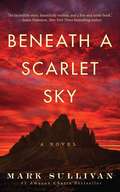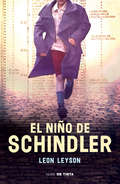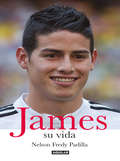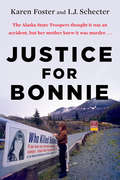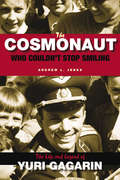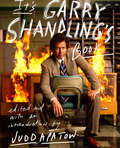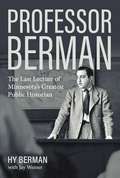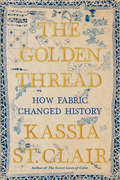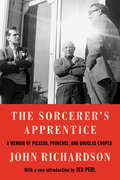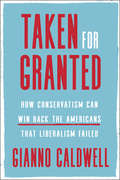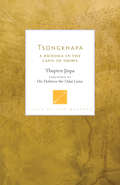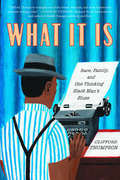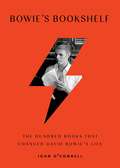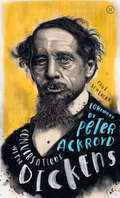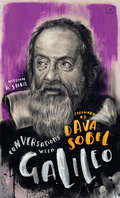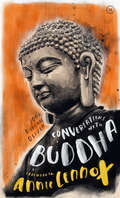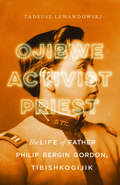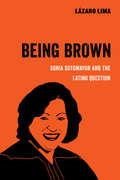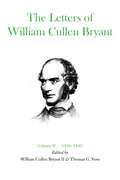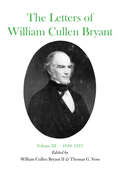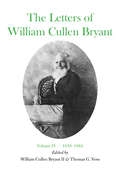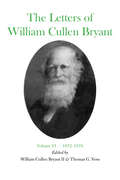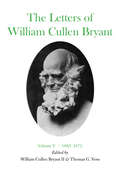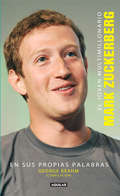- Table View
- List View
Beneath a Scarlet Sky: A Novel
by Mark SullivanPino Lella wants nothing to do with the war or the Nazis. He's a normal Italian teenager--obsessed with music, food, and girls--but his days of innocence are numbered. When his family home in Milan is destroyed by Allied bombs, Pino joins an underground railroad helping Jews escape over the Alps, and falls for Anna, a beautiful widow six years his senior. <P><P>In an attempt to protect him, Pino's parents force him to enlist as a German soldier--a move they think will keep him out of combat. But after Pino is injured, he is recruited at the tender age of eighteen to become the personal driver for Adolf Hitler's left hand in Italy, General Hans Leyers, one of the Third Reich's most mysterious and powerful commanders. <P><P>Now, with the opportunity to spy for the Allies inside the German High Command, Pino endures the horrors of the war and the Nazi occupation by fighting in secret, his courage bolstered by his love for Anna and for the life he dreams they will one day share. <P><P>Fans of All the Light We Cannot See, The Nightingale, and Unbroken will enjoy this riveting saga of history, suspense, and love.
El niño de Schindler
by Leon LeysonLa conmovedora historia de Leon Leyson, el más joven de los mil judíos que Oskar Schindler salvó del Holocausto Leon solo tenía diez años cuando el ejército nazi invadió Polonia y su familia fue trasladada primero al gueto y, más tarde, al campo de concentración. Sobrevivió gracias a su valentía y determinación, pero solo un acto de bondad desinteresada pudo salvarlo: la lista de personas que creó Oskar Schindler, el empresario alemán cuya gesta se llevó a la gran pantalla en La lista de Schindler. Estas memorias, el único testimonio que tenemos de esta historia real, retratan a la perfección la inocencia de un niño que sufrió lo inimaginable y, aun así, supo conservar la dignidad, la esperanza y la fe en la humanidad.
James, su vida
by Nelson Freddy PadillaLa biografía de uno de los mejores jugadores colombianos de fútbol de los últimos tiempos. Después de entrevistar a más de 60 personas entre amigos, familiares, entrenadores y jugadores cercanos a James Rodríguez, recoger decenas de fotografías desde su infancia y de recorrer sus pasos, Nelson Fredy Padilla, autor de este libro, logra reconstruir con la minucia de un detective privado la vida de un niño que muy rápido se hizo hombre y que hoy hace parte del más selecto grupo de jugadores de élite internacional. Este libro es la confirmación de que en el fútbol, a la perseverancia, al sacrificio y al talento innato a veces le siguen la fama y felicidad absolutas..La vida de James está llena de gloria y esfuerzo y por eso todavía sus amigos recuerdan el día que su profesor de matemáticas lo regañó y le dijo: 'Acuérdese de que tiene que educar se porque usted es el hombre de la casa. O es que piensa vivir del fútbol'. Ante lo que James respondió: 'Sí señor. Amo el fútbol y voy a vivir del fútbol'
Justice for Bonnie: An Alaskan Teenager's Murder And Her Mother's Tireless Crusade For The Truth
by I. J. Schecter Karen FosterWhen Karen Foster was told that something had happened to her eighteen-year-old daughter, Bonnie Craig, she knew what it meant. The Alaska State Troopers investigating the scene ruled it a hiking accident, but for Karen, the pieces didn't add up. Bonnie would never have ditched class to go hiking. And she didn't drive--so how would she have reached McHugh Creek, miles out of town, in the first place? Armed with little more than her own conviction, Karen set out to find the truth behind her daughter's death. After a long series of false leads and dead ends, it seemed the case would forever go unsolved. Then, after twelve years of public campaigning, private despair, and increasingly tense dealings with the detectives working the case, Karen received an e-mail that would change everything; the system, at long last, had produced a match for the unknown DNA in the case--from a man in a jail all the way across the country. Here is the chilling tale of a mother's unflagging fight to track down the monster who stole her daughter's life--and the battle to ensure that he, and others like him, would no longer be able to evade justice. INCLUDES PHOTOS
The Cosmonaut Who Couldn't Stop Smiling: The Life And Legend Of Yuri Gagarin
by Andrew Jenks"Let’s go!" With that, the boyish, grinning Yuri Gagarin launched into space on April 12, 1961, becoming the first human being to exit Earth’s orbit. The twenty-seven-year-old lieutenant colonel departed for the stars from within the shadowy world of the Soviet military-industrial complex. Barbed wires, no-entry placards, armed guards, false identities, mendacious maps, and a myriad of secret signs had hidden Gagarin from prying outsiders not even his friends or family knew what he had been up to. Coming less than four years after the Russians launched Sputnik into orbit, Gagarin’s voyage was cause for another round of capitalist shock and Soviet rejoicing. The Cosmonaut Who Couldn’t Stop Smiling relates this twentieth-century icon’s remarkable life while exploring the fascinating world of Soviet culture.
It's Garry Shandling's Book
by Edited an introduction by Judd ApatowFrom Judd Apatow comes an intimate portrait of his mentor, the legendary stand-up comic and star of The Larry Sanders Show, with never-before-seen journal entries and photos, as well as new contributions by fellow comedians and writers. Garry Shandling was a singular trailblazer in the comedy world. His two hit shows, It&’s Garry Shandling&’s Show and The Larry Sanders Show, broke new ground and influenced future sitcoms like 30 Rock and Curb Your Enthusiasm, and his stand-up laid the foundation for a whole new generation of comics. There&’s no one better to tell Shandling&’s story than Judd Apatow—Shandling gave Apatow one of his first jobs and remained his mentor for the rest of his life—and the book expands on Apatow&’s Emmy Award-winning HBO documentary, The Zen Diaries of Garry Shandling.Here, Apatow has gathered journal entries, photographs, and essays for a close-up look at the artist who turned his gaze back onto the world of show business. Beyond his success, though, Shandling struggled with fame, the industry of art, and the childhood loss of his brother, which forever affected his personal and professional lives. His diaries show Shandling to be self-aware and insightful, revealing a deep philosophical and spiritual side. Contributions by comedians and other leading lights of the industry, as well as people who grew up with Shandling, along with never-before-seen pieces of scripts and brilliant jokes that he never performed, shed new light on every facet of his life and work. This book is the final word on the lasting impact of the great Garry Shandling.
Professor Berman: The Last Lecture of Minnesota's Greatest Public Historian
by Hy Berman Jay WeinerBehind the scenes of Minnesota history, by way of the engaging life story of the state’s best-known and beloved political observer Professor Hy Berman (1925–2015) was, by most accounts, the face of public history in Minnesota for many decades—a peerless political observer and labor historian, popular lecturer and university professor, and familiar presence on the Twin Cities PBS show Almanac, dependably interpreting Minnesota history—and making some of his own. In Professor Berman: The Last Lecture of Minnesota’s Greatest Public Historian, readers encounter the Hy Berman audiences and students loved, telling stories as only he could—stories that are at once a close-up view of Minnesota history and a conversational self-portrait of a man who often found himself in the middle of that history even as it was unfolding. Berman came by his passion for history and politics naturally: as the “red diaper baby” of left-wing, Yiddish-speaking Polish immigrants in New York. With humor, sharp wit, and the insight of wisdom acquired over ninety years, he takes us back to that heady 1920s milieu that set him on a path that would one day lead to, among other adventures, a brush with the House Un-American Activities Committee, a role in a black student takeover on the University of Minnesota campus, and a lifelong alliance with Minnesota’s “Happy Warrior” for civil rights, Hubert Humphrey. Featuring an all-star cast of the state’s politicians (from Humphrey to Rudy Perpich, Harold Stassen, Arne Carlson, and Jesse Ventura) and full of engaging, often surprising anecdotes, Berman’s “last lecture” describes a rich life devoted to teaching that reached far beyond the classroom—and that found the professor translating history for an avid TV audience, helping to appoint the state’s first female Supreme Court justice, and testifying at Minnesota’s landmark tobacco trial. Edited and with an Introduction and Afterword by long-time Twin Cities journalist Jay Weiner, Hy Berman’s final lecture is a strong and powerful contribution to Minnesota’s story.
The Golden Thread: How Fabric Changed History
by Kassia St. ClairA Sunday Times (UK) Book of the Year Shortlisted • Society of Authors' Somerset Maugham Award A BBC Radio 4 Book of the Week The best-selling author of The Secret Lives of Color returns with this rollicking narrative of the 30,000-year history of fabric, briskly told through thirteen charismatic episodes. From colorful 30,000-year-old threads found on the floor of a Georgian cave to the Indian calicoes that sparked the Industrial Revolution, The Golden Thread weaves an illuminating story of human ingenuity. Design journalist Kassia St. Clair guides us through the technological advancements and cultural customs that would redefi ne human civilization—from the fabric that allowed mankind to achieve extraordinary things (traverse the oceans and shatter athletic records) and survive in unlikely places (outer space and the South Pole). She peoples her story with a motley cast of characters, including Xiling, the ancient Chinese empress credited with inventing silk, to Richard the Lionhearted and Bing Crosby. Offering insights into the economic and social dimensions of clothmaking—and countering the enduring, often demeaning, association of textiles as “merely women’s work”—The Golden Thread offers an alternative guide to our past, present, and future.
The Sorcerer's Apprentice: A Memoir of Picasso, Provence, and Douglas Cooper
by John RichardsonJohn Richardson's riveting memoir about growing up in England and, at twenty-five, beginning his twelve-year adventure with the controversial art collector Douglas Cooper. With a new introduction by Jed Perl, here is John Richardson's richly entertaining memoir of his life with the brilliant but difficult British art expert Douglas Cooper--a fiendish, colorful, Evelyn Waugh-like figure who single-handedly assembled the world's most important private collection of Cubist paintings. John Richardson tells the story of their ill-fated but comical association, which began in London in 1949 when Richardson was twenty-five and moved onto the Château de Castille, the famous colonnaded folly in Provence that they restored and filled with masterpieces by Picasso, Braque, Léger, and Juan Gris. Richardson unfurls a fascinating adventure through twelve years, encompassing famous artists and writers, collectors and other celebrities--Francis Bacon, Jean Cocteau, Luis Miguel Dominguín, Dora Maar, Peggy Guggenheim, and Henri Matisse, to name only a few. And central to the book is Richardson's close friendship with Picasso, which coincided with the emergence of the artist's new mistress, Jacqueline Roque, and gave Richardson an inside view of the repercussions she would have on Picasso's life and work.With an eye for detail, an ear for scandal, and a sparkling narrative style, Richardson has written a unique, fast-paced saga of modernism behind the scenes.
Taken for Granted: How Conservatism Can Win Back the Americans That Liberalism Failed
by Gianno CaldwellA Fox News political analyst tackles some of our communities&’ toughest challenges with timely insight from his own life: the story of how conservative values helped a kid from the South Side of Chicago find a life of opportunity.&“A must-read.&”—Brian Kilmeade, bestselling author of Sam Houston and the Alamo AvengersBorn to a mother consumed by drugs and raised by his grandmother in poverty on the South Side of Chicago, Gianno Caldwell saw firsthand how lawmakers from both parties have failed African American voters on issues like poverty, welfare, and education. But as someone who beat the odds growing up under a fear-based mentality that limits what people can achieve, Caldwell believes there&’s another way.In this groundbreaking book, the Fox News analyst describes his personal journey while detailing a hopeful vision for a nation no longer beholden to identity politics and self-limitations. Trapped within the expectations and traditions of our communities, families, political parties, faith, race, and gender, we fail to challenge our politicians and ourselves to create real change. Now more than ever, we need to confront preconceived notions about the Democrats and Republicans, public policy, and American history. Looking at the obstacles facing urban communities, such as crime, education, and social mobility, Caldwell digs beneath the statistics. By spotlighting the moments that enabled his rise to success, he proffers steps that can help more people overcome the odds—whether through policy reform or the heroic efforts of men and women who are already working to make a difference in their own communities.
Tsongkhapa: A Buddha in the Land of Snows (Lives Of The Masters Ser. #No. 18)
by Thupten JinpaThe new standard work and definitive biography of Tsongkhapa, one of the principle founders of the Gelug school of Tibetan Buddhism--the school of the Dalai Lamas. In this groundbreaking addition to the Lives of the Masters series, Thupten Jinpa, a scholar-practitioner and long-time translator for His Holiness the Dalai Lama, offers the most comprehensive portrait available of Jé Tsongkhapa (1357–1419), one of the greatest Buddhist teachers in history. A devout monastic, Tsongkhapa took on the difficult task of locating and studying all of the Indian Buddhist classics available in Tibet in his day. He went on to synthesize this knowledge into a holistic approach to the path of awakening. In an achievement of incredible magnitude, he integrated the pivotal yet disparate Mahayana teachings on emptiness while retaining the important role of critical reason and avoiding the extreme of negating the reality of the everyday world. Included in this volume is a discussion of Tsongkhapa&’s early life and training; his emergence as a precociously intelligent Buddhist mind; the composition of his Great Treatise on the Stages of the Path to Enlightenment, Great Exposition of Tantra, and many other important works; and his founding of the Lhasa Prayer Festival and Ganden Monastery. This is a necessary resource for anyone interested in Tsongkhapa&’s transformative effect on the understanding and practice of Buddhism in Tibet in his time and his continued influence today.
What It Is: Race, Family, and One Thinking Black Man's Blues
by Clifford ThompsonAn African-American writer's concise, heartfelt take on the state of his nation, exploring the war between the values he has always held and the reality with which he is confronted in twenty-first-century America.In the tradition of James Baldwin's The Fire Next Time and Ta-Nehisi Coates's Between the World and Me comes Clifford Thompson's What It Is. Thompson was raised to believe in treating every person of every color as an individual, and he decided as a young man that America, despite its history of racial oppression, was his home as much as anyone else's. As a middle-aged, happily married father of biracial children, Thompson finds himself questioning his most deeply held convictions when the race-baiting Donald Trump ascends to the presidency—elected by whites, whom Thompson had refused to judge as a group, and who make up the majority in this country Thompson had called his own. In the grip of contradictory emotions, Thompson turns for guidance to the wisdom of writers he admires while knowing that the answers to his questions about America ultimately lie in America itself. Through interviews with a small but varied group of Americans he hears sharply divergent opinions about what is happening in the country while trying to find his own answers—conclusions based not on conventional wisdom or on what he would like to believe, but on what he sees.
Bowie's Bookshelf: The Hundred Books that Changed David Bowie's Life
by John O'ConnellNamed one of Entertainment Weekly&’s 12 biggest music memoirs this fall. &“An artful and wildly enthralling path for Bowie fans in particular and book lovers in general.&” —Publishers Weekly (starred review) &“The only art I&’ll ever study is stuff that I can steal from.&” ―David Bowie Three years before David Bowie died, he shared a list of 100 books that changed his life. His choices span fiction and nonfiction, literary and irreverent, and include timeless classics alongside eyebrow-raising obscurities.In 100 short essays, music journalist John O&’Connell studies each book on Bowie&’s list and contextualizes it in the artist&’s life and work. How did the power imbued in a single suit of armor in The Iliad impact a man who loved costumes, shifting identity, and the siren song of the alter-ego? How did The Gnostic Gospels inform Bowie&’s own hazy personal cosmology? How did the poems of T.S. Eliot and Frank O&’Hara, the fiction of Vladimir Nabokov and Anthony Burgess, the comics of The Beano and The Viz, and the groundbreaking politics of James Baldwin influence Bowie&’s lyrics, his sound, his artistic outlook? How did the 100 books on this list influence one of the most influential artists of a generation? Heartfelt, analytical, and totally original, Bowie&’s Bookshelf is one part epic reading guide and one part biography of a music legend.
Conversations with Dickens: A Fictional Dialogue Based on Biographical Facts
by Paul SchlickeSheltering from a summer downpour, you encounter the ghost of Charles Dickens. Join him for a chat in the inn beloved by Mr Pickwick and be swept away by his vigour, warmth and humanity. You&’ll feel as if you&’ve known him all your life.The great novelist Charles Dickens attracted international adulation on an unprecedented scale. He cultivated a genial intimacy with his readers, and after he died many of his admirers felt that they had lost a personal friend. Sit back and listen to this master conversationalist talk about everything from work in a boot-polish factory to lecture tours in America.Who could possibly ask for more?
Conversations with Galileo: A Fictional Dialogue Based on Biographical Facts
by William SheaWhen Galileo Galilei pointed his telescope to the skies, he ushered in a scientific revolution: the Moon turned out to be covered with mountains and craters, stars popped out of nowhere, and four satellites were found to be orbiting Jupiter. His discovery of the phases of Venus in 1610 forever shattered the notion that the Sun orbited the Earth and transformed humanity&’s sense of itself and its place in the cosmos. It also contributed to the demise of the idea that knowledge about the world was to be found in ancient texts or supernatural authority.Eavesdrop on an enlightening conversation, and make your own discoveries – about Galileo&’s life in the Medici court, his love of wine and women, and how he came to spend his last eight years under house arrest.
Conversations with Buddha: A Fictional Dialogue Based on Biographical Facts
by Joan Duncan OliverA relaxed chat with the Buddha tells us what he thought about impermanence, karma, mindfulness, compassion, love, and everything else that leads us toward a true understanding of ourselves and the cosmos.We know him as the Buddha, the &“Awakened One&”. Born Siddhartha Gautama 2,500 years ago in northern India, he became one of the world&’s greatest spiritual leaders. He suffered as we do, then by his own efforts found the key to liberation from the bonds of desire, hatred and ignorance. As Westerners living in relative prosperity, we can identify with this man who had it all – love, success, money, talent, privilege – but set these things aside to search for something deeper and more enduring. This book presents an account of the Buddha&’s life followed by a series of plausible and illuminating but imagined conversations, which probe all aspects of his philosophy for living. The insights he conveys here offer us practical wisdom for a better life.
Beneath a Scarlet Sky by: A Novel
by Mark SullivanBased on the true story of a forgotten hero, Beneath a Scarlet Sky is the triumphant, epic tale of one young man’s incredible courage and resilience during one of history’s darkest hours. Pino Lella wants nothing to do with the war or the Nazis. He’s a normal Italian teenager—obsessed with music, food, and girls—but his days of innocence are numbered. When his family home in Milan is destroyed by Allied bombs, Pino joins an underground railroad helping Jews escape over the Alps, and falls for Anna, a beautiful widow six years his senior. In an attempt to protect him, Pino’s parents force him to enlist as a German soldier—a move they think will keep him out of combat. But after Pino is injured, he is recruited at the tender age of eighteen to become the personal driver for Adolf Hitler’s left hand in Italy, General Hans Leyers, one of the Third Reich’s most mysterious and powerful commanders. Now, with the opportunity to spy for the Allies inside the German High Command, Pino endures the horrors of the war and the Nazi occupation by fighting in secret, his courage bolstered by his love for Anna and for the life he dreams they will one day share.
Ojibwe, Activist, Priest: The Life of Father Philip Bergin Gordon, Tibishkogijik
by Tadeusz LewandowskiBeing Brown: Sonia Sotomayor and the Latino Question (American Studies Now: Critical Histories of the Present #9)
by Lázaro LimaBeing Brown: Sonia Sotomayor and the Latino Question tells the story of the country’s first Latina Supreme Court Associate Justice’s rise to the pinnacle of American public life at a moment of profound demographic and political transformation. While Sotomayor’s confirmation appeared to signal the greater acceptance and inclusion of Latinos—the nation’s largest “minority majority”—the uncritical embrace of her status as a “possibility model” and icon paradoxically erased the fact that her success was due to civil rights policies and safeguards that no longer existed. Being Brown analyzes Sotomayor’s story of success and accomplishment, despite seemingly insurmountable odds, in order to ask: What do we lose in democratic practice when we allow symbolic inclusion to supplant the work of meaningful political enfranchisement? In a historical moment of resurgent racism, unrelenting Latino bashing, and previously unimaginable “blood and soil” Nazism, Being Brown explains what we stand to lose when we allow democratic values to be trampled for the sake of political expediency, and demonstrates how understanding “the Latino question” can fortify democratic practice. Being Brown provides the historical vocabulary for understanding why the Latino body politic is central to the country’s future and why Sonia Sotomayor’s biography provides an important window into understanding America, and the country’s largest minority majority, at this historical juncture. In the process, Being Brown counters “alternative facts” with historical precision and ethical clarity to invigorate the best of democratic practice at a historical moment when we need it most.
The Letters of William Cullen Bryant: Volume II, 1836–1849
by William Cullen BryantThe second volume of William Cullen Bryant's letters opens in 1836 as he has just returned to New York from an extended visit to Europe to resume charge of the New York Evening Post, brought near to failure during his absence by his partner William Leggett's mismanagement. At the period's close, Bryant has found in John Bigelow an able editorial associate and astute partner, with whose help he has brought the paper close to its greatest financial prosperity and to national political and cultural influence.Bryant's letters lf the years between show the versatility of his concern with the crucial political, social, artistic, and literary movements of his time, and the varied friendships he enjoyed despite his preoccupation with a controversial daily paper, and with the sustenance of a poetic reputation yet unequaled among Americans. As president of the New York Homeopathic Society, in letters and editorials urging widespread public parks, and in his presidency of the New York Society for the Abolition of the Punishment of Death, he gave attention to public health, recreation, and order. He urged the rights of labor, foreign and religious minorities, and free African Americans; his most powerful political effort of the period was in opposition to the spread of slavery through the conquest of Mexico. An early commitment to free trade in material goods was maintained in letters and editorials, and to that in ideas by his presidency of the American Copyright Club and his support of the efforts of Charles Dickens and Harriet Martineau to secure from the United States Congress and international copyright agreement.Bryant's first visit to Great Britain came at the height of his poetic and journalistic fame in 1845, bringing him into cordial intimacy with members of Parliament, scientists, journalists, artists, and writers. In detailed letters to his wife, published here for the first time, he describes the pleasures he took in breakfasting with the literary patron Samuel Rogers and the American minister Edward Everett, boating on the Thames with artists and with diarist Henry Crabb Robinson, spending an evening in the home of Leigh Hunt, and calling on the Wordsworths at Rydal Mount as well as in the distinctions paid him at a rally of the Anti-Corn-Law League in Covent Garden Theatre, and at the annual meeting in Cambridge of the British Association for the Advancement of Science.Equally fresh are most of the letters to prominent Americans, many of them his close friends, such as the two Danas, Bancroft, Cole, Cooper, Dewey, Dix, Downing, Durand, Forrest, Greenough, Irving, Longfellow, Simms, Tilden, Van Buren, and Weir. His letters to the Evening Post recounting his observations and experiences during travels abroad and in the South, West, and Northeast of the United States, which were copied widely in other newspapers and praised highly by many of their subscribers, are here made available to the present-day reader.
The Letters of William Cullen Bryant: Volume III, 1849–1857
by William Cullen BryantDuring the years covered in this volume, Bryant traveled more often and widely than at any comparable period during his life. The visits to Great Britain and Europe, a tour of the Near East and the Holy Land, and excursions in Cuba, Spain, and North Africa, as well as two trips to Illinois, he described in frequent letters to the Evening Post. Reprinted widely, and later published in two volumes, these met much critical acclaim, one notice praising the "quiet charm of these letters, written mostly from out-of-the-way places, giving charming pictures of nature and people, with the most delicate choice of words, and yet in the perfect simplicity of the true epistolary style."His absence during nearly one-fifth of this nine-year period reflected the growing prosperity of Bryant's newspaper, and his confidence in his editorial partner John Bigelow and correspondents such as William S. Thayer, as well as in the financial acumen of his business partner Isaac Henderson. These were crucial years in domestic politics, however, and Bryant's guidance of Evening Post policies was evident in editorials treating major issues such as the Compromise of 1850, the Fugitive Slave Law, the Kansas-Nebraska Bill, the rise of the Republican Party, and the Dred Scott Decision, as well as in his correspondence with such statesmen as Salmon P. Chase, Hamilton Fish, William L. Marcy, Edwin D. Morgan, and Charles Sumner. His travel letters and journalistic writings reflected as well his acute interest in a Europe in turmoil. In France and Germany he saw the struggles between revolution and repression; in Spain he talked with journalists, parliamentary leaders, and the future president of the first Spanish republic; in New York he greeted Louis Kossuth and Giuseppe Garibaldi.Bryant's close association with the arts continued. He sat for portraits to a dozen painters, among them Henry P. Gray, Daniel Huntington, Asher Durand, Charles L. Elliott, and Samuel Laurence. The landscapists continued to be inspired by his poetic themes. Sculptor Horatio Greenough asked of Bryant a critical reading of his pioneering essays on functionalism. His old friend, the tragedian Edwin Forrest, sought his mediation in what would become the most sensational divorce case of the century, with Bryant and his family as witnesses. His long advocacy of a great central park in New York was consummated by the legislature. And in 1852, his eulogy on the life of James Fenimore Cooper became the first of several such orations which would establish him as the memorialist of his literary contemporaries in New York.
The Letters of William Cullen Bryant: Volume IV, 1858–1864
by William Cullen BryantThe years just before and during the Civil War marked the high point of Bryant's influence on public affairs, which had grown steadily since the Evening Post had upheld the democratic Jacksonian revolution of the 1830s. A founder of the Free Soil Party in 1848 and the Republican Party in 1856, Bryant was lauded in 1857 by Virginia anti-slavery leader John Curtis Underwood, who wrote to Eli Thayer, "What a glory it would be to our country if it could elect this man to the Presidency-the country not he would be honored & elevated by such an event."In 1860 Bryant helped secure the Presidential nomination for Abraham Lincoln, and was instrumental in the choice of two key members of his cabinet, Salmon Chase as Secretary of the Treasury, and Gideon Welles as Secretary of the Navy. During disheartening delays and defeats in the early war years, direct communications from Union field commanders empowered his editorial admonitions to such a degree that the conductor of a national magazine concluded that the Evening Post's "clear and able political leaders have been of more service to the government of this war than some of its armies."Bryant's correspondence with statesmen further reflects the immediacy of his concern with military and political decisions. There are thirty-five known letters to Lincoln, and thirty-two to Chase, Welles, war secretary Stanton, and Senators Fessenden, Morgan, and Sumner.This seven-year passage in Bryant's life, beginning with his wife's critical illness at Naples in 1858, concludes with a unique testimonial for his seventieth birthday in November 1864. The country's leading artists and writers entertained him at a "Festival" in New York's Century Club, giving him a portfolio of pictures by forty-six painters as a token of the "sympathy" he had "ever manifested toward the Artists," and the "high rank" he had "ever accorded to art." Poets Emerson, Holmes, Longfellow, Lowell, and Whittier saluted him in prose and verse. Emerson saw him as "a true painter of the face of this country"; Holmes, as the "first sweet singer in the cage of our close-woven life." To Whittier, his personal and public life sounded "his noblest strain." And in the darkest hours of the war, said Lowell, he had "remanned ourselves in his own manhood's store," had become "himself our bravest crown."
The Letters of William Cullen Bryant: Volume VI, 1872–1878
by William Cullen BryantIn January 1872, Bryant traveled to Mexico City, where he was greeted warmly by President Benito Juarez; on this and other occasions he was feted for the Evening Post's sturdy condemnation in 1863 of the abortive invasion of Mexico, which was freshly remembered there. AT the close of his visit a local newspaper remarked that the "honors and hospitality which were so lavishly and generously conferred upon him were the spontaneous outpouring of a grateful people, who had not forgotten that when Mexico was friendless Mr. Bryant became her friend." Returning in April through New Orleans and up the Mississippi by steamboat to Cincinnati, he was greeted at a public reception by Governor Rutherford Hayes, who was pleased by his "winning and lovable" manners and "pithy" anecdotes.That spring Bryant built a library for his birthplace, Cummington, stocking it with several thousand books procured for him by the publisher George Palmer Putnam in New York and London. The following year, after the last of his many travels - this time a revisit to South Carolina and Florida - he made a similar gift to Roslyn. These benefactions won him honorary membership in the newly formed American Library Association, and an invitation to open a library at Princeton University, which made him an honorary doctor of letters. Ultimately, in the final year of his life, his plans for the Bryant Library at Cummington, solicited from the White House by President Hayes, provided the basic design for the first presidential library in the country - that established by Hayes in Fremont, Ohio.An improbable by-product of the presidential race in 1872 was a proposal by leading journalists that Bryant become -in his seventy-eighth year - a candidate to oppose President Grant and his challenger for the Republican nomination, the mercurial editor of the New York Tribune, Horace Greeley. Bryant's immediate refusal to take the suggestion seriously was succinct, and tinged with humor. It was impossible, he declared in his newspaper, that he should receive the nomination, and "equally impossible," if it were offered, that he should "commit the folly of accepting it." Four years later he was distressed at being unable to switch his journal's support of the Republican candidate Hayes to the Democratic candidate, his old companion in political reform, Samuel Jones Tilden.As Bryant approached and entered his eighties, his writing and public speaking continued without slackening. Between 1872 and 1878 he published his collected Orations and Addresses, edited a revision of his anthology of poetry and two volumes of landscape sketches, Picturesque America, co-authored a four-volume Popular History of the United States, and undertook to co-edit a three-volume set of Shakespeare's plays, while also producing long monographs on several seventeenth-century English poets. He dedicated statues of Shakespeare, Walter Scott, and Fitz-Green Halleck in Central Park, and spoke elsewhere on Robert Burns, Benjamin Franklin, Goethe, and Shakespeare, gave speeches on Mexico and "National Honesty," and presided over the founding of the State Charities Aid Association. He was honored in Albany at receptions by each house of the legislature. For his eightieth birthday, his life's work was celebrated in silver on a Tiffany vase given him by admirers throughout the country.Bryant's last public act was to unveil, in Central Park, his brainchild of nearly a half century earlier: a bust of the Italian patriot Giuseppe Mazzini. Here, after exhaustion under the June sun, he fell and suffered a massive concussion followed by a stroke, which led to his death a fortnight later in his eighty-fourth year. A period of virtual national mourning preceded his funeral and his burial beside his wife at Roslyn. At one of many memorial services, a eulogist exclaimed, "The broad outline of his character had become universally familiar, like a mountain or a sea. Whoever saw Bryant saw America."
The Letters of William Cullen Bryant: Volume V, 1865–1871
by William Cullen BryantOn April 26, 1865, as Abraham Lincoln's funeral cortege paused in Union Square, New York, before being taken by rail to Springfield, Illinois, William Cullen Bryant listened as his own verse elegy for the slain president was read to a great concourse of mourners by the Reverend Samuel Osgood. Only five years earlier and a few blocks downtown, at Cooper Union, Bryant had introduced the prairie candidate to his first eastern audience. There his masterful appeal to the conscience of the nation prepared the way for his election to the presidency on the verge of the Civil War. Now, Bryant stood below Henry Kirke Brown's equestrian statue of George Washington, impressing Osgood as if he were "the 19tth Century itself thinking over the nation and the age in that presence." Bryant's staunch support of the Union cause throughout the war, and of Lincoln's war efforts, no less than his known influence with the president, led several prominent public figures to urge that he write Lincoln's biography. Oliver Wendell Holmes wrote him, "No man combines the qualities for his biographer so completely as yourself and the finished task would be a noble crown to a noble literary life." But Bryant declined, declaring his inability to record impartially critical events in which he had taken so central a part. Furthermore, while preoccupied with the editorial direction of the New York Evening Post, he was just then repossessing and enlarging his family's homestead at Cummington, Massachusetts, where he hoped his ailing wife might, during long summers in mountain air, regain her health. But in July 1866, Frances died of recurrent rheumatic fever, and, Bryant confessed to Richard Dana, he felt as "one cast out of Paradise." After France's death Bryant traveled with his daughter Julia for nearly a year through Great Britain and the Continent, where he met British statesman and novelist Edward Bulwer Lytton and French literary critic Hyppolyte Taine, renewed his friendship with Spanish poet Carolina Coronado, Italian liberator Giuseppe Garibaldi, and British and American artists, and visited the family of the young French journalist Georges Clemenceau, as well as the graves of earlier acquaintances Francis Lord Jeffrey and Elizabeth Barrett Browning. In his spare moments Bryant sought solace by beginning the translation of Homer, and Longfellow had found relief after his wife's tragic death by rendering into English Dante's Divine Comedy. Home again in New York, Bryant bought and settled in a house at 24 West 16th Street which would be his city home for the rest of his life. Here he completed major publications, including the Iliad and Odyssey of Homer and an exhaustive Library of Poetry and Song, and added to published tributes to earlier friends, such as Thomas Cole, Fenimore Cooper, and Washington Irving, memorial discourses on Fitz-Greene Halleck and Gulian Verplanck. In addition to his continued direction of the New York Homeopathic Medical college and the American Free Trade League, he was elected to the presidency of the Williams College Alumni Association, the International Copyright Association, and the Century Association, the club of artists and writers of which, twenty years earlier, he had been a principal founder and which he would direct for the last decade of his life.
El joven multimillonario Mark Zuckerberg en sus propias palabras: Mark Zuckerberg In His Own Words (In Their Own Words Ser.)
by George BeahmEl primer y único libro que detalla los pensamientos visionarios y las opiniones del fundador de Facebook de manera contundente. Un panorama claro y directo para entender a Zuckerberg y la compañía que fundó; sus puntos de vista, estrategias de negocio y las lecciones aprendidas con el tiempo. Mark Zuckerberg se ha convertido rápidamente en un prominente personaje, con la misma velocidad que la compañía que fundó en su dormitorio de Harvard, en 2004. El deseo de la gente por saber qué pasa dentro de Facebook y con su fundador, parece insaciable. La personalidad y el estilo empresarial de Zuckerberg despiertan una gran curiosidad; retratos ficticios de Hollywood y rumores de Wall Street han armado el rompecabezas de este joven emprendedor, innovador y visionario. Dada la capitalización actual de Facebook en el mercado y la cantidad de usuarios a nivel mundial claramente hay mucho más de Zuckerberg que cualquier retrato simplificado puede transmitir. El chico multimillonario: Mark Zuckerberg en sus propias palabras es el acercamiento más íntimo y con mayor autoridad del hombre detrás de Facebook y la generación entera que le dio tanto éxito; el aparente heredero tecnológico de Steve Jobs y Bill Gates habla de la tecnología, la innovación, la privacidad, los hackers, Facebook, Harvard, los gemelos Winklevoss y su ex socio Eduardo Saverin. Como el pionero emprendedor que es, Zuckerberg ha probado ser un estratega calculador y sin escrúpulos, comprometido de manera absoluta con su visión. Facebook existe actualmente como una herramienta social para mantener una comunicación viva y de primer nivel, y un modelo de negocios del siglo XXI que lleva a las compañías de tecnología de la siguiente generación hacia un clima económico motivado por la inevitabilidad de un mercado global saturado de tecnología social. El potencial de Facebook es desconocido, pero la clave de su éxito depende de las ideas y la visión de "Zuck".
